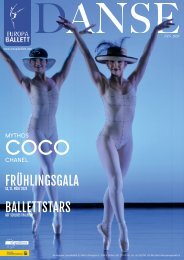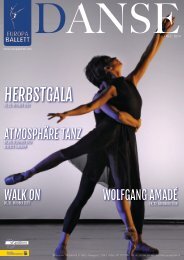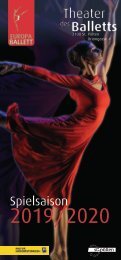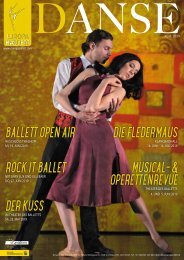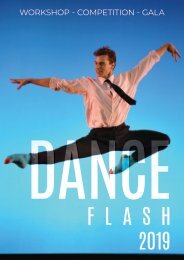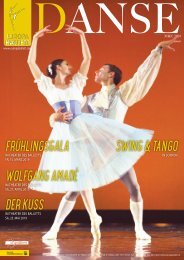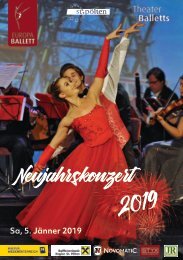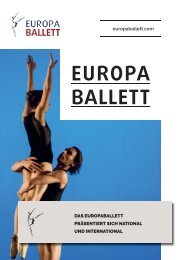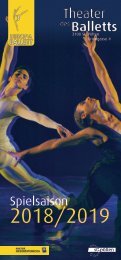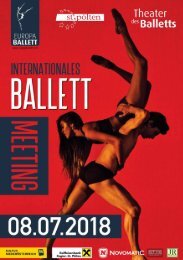Programmheft Rijeka_10_18_1
You also want an ePaper? Increase the reach of your titles
YUMPU automatically turns print PDFs into web optimized ePapers that Google loves.
www.europaballett.com<br />
28. OCTOBER 20<strong>18</strong><br />
HNK Ivan Zajc <strong>Rijeka</strong>
The initiative for the “European Capital<br />
of Culture” project dates back to 1985,<br />
when Greek Minister of Culture Melina<br />
Mercouri came up with the idea. To this day,<br />
the European Capital of Culture project is one<br />
of the most popular projects in the European<br />
Union, bringing the European population closer<br />
together and promoting cultural exchange.<br />
Learning about other cultures, getting involved<br />
in intercultural dialogue and summing up the<br />
common European history will enhance the<br />
sense of coherence in the European Community.<br />
<strong>Rijeka</strong> and St. Pölten contribute their part to this<br />
project. <strong>Rijeka</strong> as European Capital of Culture<br />
for the year 2020 and St. Pölten as candidate for<br />
the title of European Capital of Culture 2024.<br />
Certainly an important step in this direction is<br />
the “Euro Tour” with the „Austrian Ballet Gala“,<br />
during which the European Ballet St. Pölten is<br />
dancing in the Croatian National Theater Ivan<br />
Zajc.
Music in connection with dance is comprehensible and connects people<br />
of all cultures. The Europaballett St. Pölten conveys culture as a national<br />
and international message. Dancers from 14 nations dance under the<br />
direction of Michael Fichtenbaum - from Austria, Great Britain, Mexico,<br />
Brazil, France, Ukraine, Russia, Peru, Slovenia, Georgia, Australia,<br />
Cyprus, Syria and South Africa. These gives the company its international<br />
flair.<br />
In addition to professional dancers, choreographers with a classical<br />
and modern repertoire are required to offer the audience a varied<br />
program. Renato Zanella, Artur Kolmakov, Peter Breuer, Reiner Feistel<br />
and, of course, Michael Fichtenbaum are the internationally acclaimed<br />
choreographers with a variety of styles.<br />
In the summer the ensemble goes on tour and dances again and again at<br />
the operetta summer in Kufstein and the music festival in Steyr. In 2016, the<br />
ballet followed the call of the Salzburg Festival and provided a valuable<br />
dance contribution in the opera „The Love of Danae“. The Europaballett<br />
is present internationally with guest performances in China, Japan, Hong<br />
Kong, Singapore, New York, Washington, Chicago, Johannesburg, Baku,<br />
Moscow and all European cities - and thus one of the largest advertising<br />
media of Lower Austria as well as the state capital St. Pölten.<br />
With pleasure and pride Michael Fichtenbaum can announce that star<br />
dancer like Karina Sarkissova (State Ballet Budapest), Kirill Kourlaev<br />
(Vienna State Opera), Maria Abashova (Boris Eifmann Ballet) and Natalie<br />
Kush (Royal Ballet), arose from the forge of the “Europaballett”. The State<br />
Opera Ballet director Renato Zanella dedicated many graduates from<br />
St. Pölten to the Vienna State Opera. By 2017 more than 80 contestants<br />
from the Europaballett St. Pölten were discovered to dance on the famous<br />
stages of the world. In 2011, the former governor Dr. Erwin Pröll awarded<br />
the cultural prize of the country to the Europaballett.
Michael Fichtenbaum<br />
Artistic Director Europaballett<br />
Michael Fichtenbaum danced<br />
with ballet stars like Rudolf<br />
Nureyev, Paolo Bortoluzzi, Mikhail<br />
Baryschnikow and Judith Jamison on<br />
the stage of the Vienna state opera as<br />
the youngest member of the company.<br />
Already at the age of 30 he discovered<br />
his true muse: choreography and<br />
pedagogy. In this way he could realize<br />
his artistic creativity. In 1990 he made<br />
a breakthrough with the founding of<br />
the “Europaballett”. The special gift to<br />
recognize the talent of young dancers<br />
and the spirit to promote them were<br />
the driving force for the founding of<br />
the ballet conservatory with vocational<br />
training in 1997. It is important for<br />
Michael Fichtenbaum to win the<br />
International Stars for performances<br />
with the Europaballett. In previous years<br />
there were celebrities such as Vladimir<br />
Malakhov, Diana Vishneva, Andrey<br />
Batalov and Anastasia Volochkova.<br />
6
Kristina Chantal<br />
|Russia<br />
Carol Pitta<br />
|Brazil<br />
Leticia Calvete<br />
|Brazil<br />
Tamara Alves<br />
|Brazil<br />
Gala Lara<br />
|Mexico<br />
Rachael Carrier<br />
|Great Britain<br />
Beatriz Scabora<br />
|Brazil<br />
Antoinette Pylarinu<br />
|Cyprus<br />
Chiara Bettini<br />
|Italy<br />
www.europaballett.at<br />
7
Mayara Viçoso<br />
|Brazil<br />
Linda Linder<br />
|Austria<br />
Alisa Nikitina<br />
|Ukraine<br />
Miriam Genovese<br />
|Italy<br />
Florient Cador<br />
|France<br />
Dominik Vaida<br />
|Austria<br />
Thiago Neves<br />
|Brazil<br />
Matheus Segrini<br />
|Brazil<br />
Khanya Mandongana<br />
|South Africa<br />
8
Levan Tsinstsadze<br />
|Georgia<br />
Joao Ludwig<br />
|Brazil<br />
Cassiano Rodriques<br />
|Brazil<br />
Walaa Almejbl<br />
|Syria<br />
Artistic Direction: Michael Fichtenbaum<br />
Rehearsal Director: Sabina Horn, Julia Bauer and Tschulpan Usmanova<br />
Lightdesign: Philipp Preiss<br />
Costumes: Olha Malakhova and Sergej Ivanov<br />
Pictures: Ing. Wolfgang Mayer<br />
www.europaballett.at<br />
9
Renato Zanella<br />
Director ChoreoCenterEurope<br />
Renato Zanella was born in Verona on June sixth, 1961.<br />
Already as a teenager with a height of 1,86 meter, his<br />
first love was sports, primarily basketball. It was rather by<br />
chance that at age seventeen Renato came into contact<br />
with ballet. But since then he devoted his entire energy<br />
and passion to dance.<br />
Zanella received his first training in Verona before moving<br />
on to Rosella Hightower’s famous “Centre de Danse<br />
International” in Cannes where he completed his studies.<br />
He got his first work contract right away in 1982 from<br />
Heinz Spoerli in Basel. In the course of the next three years<br />
he accumulated a wealth of background and experience<br />
which stood him in good stead when he moved on to the<br />
world famous ballet company of Stuttgart in 1985.<br />
In Stuttgart, the chef de ballet, Marcia Haydée,<br />
gave Zanella not only the chance to work with great<br />
choreographers and appear in their works (such as<br />
John Cranko, Maurice Béjárt, Jiri Kylián, Mats Ek, John<br />
Neumeier, William Forsythe, Azary Plisetsky, Glen Tetley<br />
and Kenneth MacMillan) but also to realise his own<br />
creative ambitions: At age twenty-eight, in 1989, Zanella’s<br />
first own choreography for two dancers lasting for seven<br />
minutes called “Die andere Seite” (the other side) based<br />
on the music of Joachim Kühn’s “Dark” was staged.<br />
Zanella was appointed head of the ballet company of<br />
The Vienna’s State Opera in 1995, at age 34.During his<br />
ten-year term there Zanella has presented close to forty<br />
own choreographies ranging from short pieces to full<br />
length evening programmes. His Mozart ballet from 1998<br />
“Wolfgang Amadée” has achieved particular acclaim. In<br />
1999 Zanella paid homage to the local genius Johann<br />
Strauß by choosing his music for his own danced version<br />
of “Aschenbrödel” (Cinderella). Zanella has repeatedly<br />
used classical music in his works but is nevertheless also<br />
known for his close attachment to modern music. Yet, he<br />
has focused more and more on the great challenges of<br />
ballet literature such as Strawinsky’s “Sacre de printemps”<br />
(1996), Ravel’s “Bolero (1998), Tchaikovsky’s “Nutcracker”<br />
(2000) and Khachaturian’s “Spartacus” (2002). His<br />
last choreography for the Vienna State Opera was<br />
Strawinsky’s “Renard” in 2005.<br />
After leaving the Vienna State Opera Zanella expanded<br />
his wide-ranging international career. His choreographies<br />
are enacted by ballet companies not only in Europe but<br />
also in America and Asia.<br />
Renato Zanella was Director of the Greek National<br />
Opera Ballet from September 2011 till July 2015 and<br />
from September 2013 till December 2015 in the same<br />
position at the Fondazione Arena di Verona.<br />
From September 2016 till November 2017 he was Artistic<br />
Ballet Director at the Bucharest National Opera.<br />
Renato Zanella counts over 150 creations and defines<br />
himself and his work as a product born out of curiosity and<br />
the addiction to continuously experience new things, meet<br />
new personalities and talents and receive incessantly new<br />
inspirations for his work.<br />
<strong>10</strong>
Peter Breuer<br />
Salzburg Ballett<br />
Was one of the leading dancers of the international<br />
ballet scene. He was born in 1946 in Tegernsee,<br />
Germany, the son of pianist and conductor Peter Bruno<br />
Breuer, and began his ballet studies at age 11 with<br />
the reknowned pedagogue Gustav Blank, who taught<br />
him in the spirit of the old „St. Petersburg school“. At<br />
age 15, Peter Breuer joined the corps of the Munich´s<br />
Bavarian State Opera, and at 17 - after Breuer was<br />
unable to fulfill a contract with Balanchine´s New York<br />
City Ballet due to visa difficulties - he was engaged by<br />
Erich Walter in Düsseldorf as a demi-soloist. One year<br />
later he was promoted to soloist, and in 1967, principal<br />
dancer. In 1969, Peter Breuer began his international<br />
career when he was invited as a guest artist to the<br />
London Festival Ballet, which he joined as a permanent<br />
member in 1973. Yearlong associations as a guest<br />
artist included the State Operas of Berlin and Munich<br />
from 1971, Milan´s la Scala and American Ballet<br />
Theatre from 1979, and others.<br />
Without question, Peter Breuer was one of the most<br />
requested ballet dancers in the world. He gained<br />
recognition from international dance journalists and<br />
audiences worldwide on numerous foreign tours<br />
(Australia, South America, England, USA., South<br />
Africa, Yugoslavia, Poland, Czechoslovakia, France,<br />
Japan, the Phillipines...) His standard is evidenced by<br />
the fact that he danced with most of the great ballerinas<br />
of his time (Makarova, Evdokimova, Gregory, Gielgud,<br />
Fulton...) His versatility of inter-pretation enabled him<br />
to perform a broad and spectrum of roles, ranging<br />
from the standard classical repertoire to modern works<br />
(many of which were created for him) of Erich Walter,<br />
John Butler, Hans van Manen, Maurice Bejart, Jerome<br />
Robbins, John Cranko...<br />
As a logical continuation of his international career<br />
as a dancer, Peter Breuer began exploring his<br />
choreographic and teaching abilities in the early 80´s.<br />
Just as when he was a soloist, the choreographer<br />
Peter Breuer was soon in demand by inter-national<br />
theaters and companies. His variegated knowledge<br />
of repertory and his collaborations with the leading<br />
choreographers of his generation provided a sound<br />
basis for the development of his own choreographic<br />
language, and his second career.<br />
Since 1991, Peter Breuer has directed the Ballet of<br />
the Salzburg Landestheater. Under his direction, the<br />
company has developed a strong, dynamic and unique<br />
style, and earns high praise from its critics.<br />
In 1991 he formed the“Salzburg Dance Company“<br />
Parallelling his activities in Salzburg, Peter Breuer<br />
regularly creates works and traines other companies<br />
in Germany and throughout Europe.<br />
He was teaching at the University Mozarteum and<br />
Gives Masterclasses all over the world.<br />
www.europaballett.at<br />
11
Reiner Feistel<br />
Theater Ulm<br />
Feistel studied from 1973 to 1978 at the School of<br />
Dance / Ballet School of the Opera Leipzig. 1978 first<br />
engagement at the Staatsoper Dresden, from 1984<br />
he appeared as a soloist at the Semperoper Dresden.<br />
He danced there until 1997 in major and minor roles<br />
such as in Coppélia, Swan Lake, Günther Fischer‘s<br />
The Tamer, Harald Wandtkes King Lear, The Moor‘s<br />
Pavane by José Limón after Shakespeare‘s Othello,<br />
Romeo and Juliet, La Fille times gardée, but also on<br />
topics from how you like it as well as red and black.<br />
He dealt with well-known choreographers such as<br />
Harald Wandtke, Kurt Joos, Emöke Pöstenyi, Birgit<br />
Cullberg, Johannes Bönig, Stephan Thoss, Joseph<br />
Lazzini, John Neumeier or even Uwe Scholz. In 1991<br />
he brought his first solo recitals called Spiel der Forte<br />
1 and Spiel der Forte 2 on the stage, 1996 he made his<br />
debut as a choreographer at the Semperoper with the<br />
matinee de la danse.<br />
In August 1997 he was appointed Ballet Director of<br />
the Landesbühnen Sachsen, where he produced two<br />
ballet premieres in the Radebeul headquarters (once<br />
for the big stage and once for the studio stage, here<br />
many world premieres) and a danceable serenade<br />
for the Dresden Zwinger. Each year, the Reisetheater<br />
Compagnie released about <strong>10</strong>0 ballet evenings<br />
and 40 to 50 opera and operetta evenings at the<br />
venues Radebeul, Dresden, Rathen, Meißen, Freital,<br />
Großenhain and Hoyerswerda.<br />
Feistel‘s artistic work for Radebeul was honored in<br />
2008 with the Art Prize of Radebeul.<br />
After a sold-out farewell performance on July 7, 2013<br />
Feistel moved to the 2013/14 season at the Chemnitz<br />
Theater, accompanied by some of his dancers.<br />
In 2017, Reiner Feistel was awarded for the Ballet<br />
Chemnitz production faces of the city with the Ursula<br />
Cain Prize - the Saxon Dance Prize. [3]<br />
For the season 20<strong>18</strong>/19 Reiner Feistel became<br />
director of the Tanztheater at the Theater Ulm. With<br />
the Tanztheater Ulm he has resumed faces of the big<br />
city.<br />
12
Artur Kolmakov<br />
Europaballett<br />
The international choreographer and director Artur<br />
Kolmakov provides valuable creative contributions<br />
to the ensemble of the Europaballett. Kolmakov<br />
combines dance acrobatics with modern dance and<br />
thereby creates a completely new style of art. For<br />
the season 20<strong>18</strong>/2019 Artur Kolamkov stages the<br />
fantastic fantasy ballet Soluna.<br />
Born in Ukraine in 1961, he graduates from the<br />
“Government Institute of Theatre Art” in Moscow. His<br />
teacher and director of the Bolshoi Ballet Moscow,<br />
Vladimir Vasiljev, awarded “The Bright Artist” to<br />
Kolmakov. After his graduation Kolmakov founded his<br />
own dance theatre. His shows and choreographies had<br />
great success and were shown on TV. Consequently<br />
Kolmakov gets his personal TV-show: Dance Empire<br />
International. Finally Kolmakov becomes regisseur<br />
of the show-theatre in Russia, the “METROPOL” in<br />
Moscow. In 1992 his dancers took part in the 1st Int.<br />
Modern Art Festival in Vitebsk and the show “Ticket<br />
to Paradise” was awarded both the 1st prize and the<br />
“Special prize for the best entertainment”! In 1999<br />
Kolmakov started to work in Austria and Switzerland.<br />
He created modern choreographies for the “Prix de<br />
Lausanne” – Europe’s most important international<br />
dance competition – and won the 1st prize. Afterwords<br />
Kolmakov produced several modern dance shows<br />
in close cooperation with the Vienna State Opera<br />
and ballet conservatories in Berlin, Vienna and many<br />
more.Since than his Shows have successfully toured<br />
in Europe and Asia. To be successful Kolmakov<br />
engages international artists from the world’s best<br />
circus, varietès and dance companies. The secret of<br />
his success is a unique combination of high quality,<br />
professionalism and entertainment that fits the taste<br />
of the audience.<br />
www.europaballett.at<br />
13
1. Akt<br />
1. LA FELICITIA<br />
Music: W.A. Mozart<br />
Dancer: Florient Cador<br />
Choreography: F. Cador<br />
2. ROSEN AUS DEM SÜDEN WALZER<br />
Music: J. Strauss II<br />
Choreography: M. Fichtenbaum<br />
Dancer: Kristina Chantal, Joao Ludwig, Beatriz Scabora, Chiara Bettini, Mayara Vicoso, Rachael<br />
Carrier, Antoienette Pylarinu and Alisa Nikitina<br />
3. NANNERL<br />
Music: W.A. Mozart<br />
Choreography: M. Fichtenbaum<br />
Dancer: Leticia Calvete and Florient Cador<br />
4. LA SYMPHONIE 34 in C<br />
Music: W.A. Mozart<br />
Choreography: M. Fichtenbaum<br />
Dancer: Gala Lara and Joao Ludwig<br />
5. UNTER DEN ENNS Polka<br />
Music: E. Strauss<br />
Choreography: M. Fichtenbaum<br />
Dancer: Tamara Dornelas, Antoinette Pylarinu, Chiara Bettini, Alisa Nikitina, Levan Tsinsadze and<br />
Thiago Neves<br />
6. COSI FAN TUTTE<br />
Music: W.A. Mozart<br />
Choreography: M. Fichtenbaum<br />
Dancer: Rachael Carrier and Cassiano Rodriques<br />
7. UND DER LIEBESWIND...<br />
Music: E. Strauss<br />
Choreography: M. Fichtenbaum<br />
Dancer: Gala Lara and Matheus Segrini<br />
8. PAS DE DEUX from „TSCHAIKOWSKY“<br />
Music: P.I. Tschaikowsky Choreography: P. Breuer<br />
Dancer: Florient Cador and Cassiano Rodriques<br />
9. MARIA ANTOINETE<br />
Music: J.L. Dussek<br />
Choreography: P. Breuer<br />
Dancer: Carol Pitta and Matheus Segrini<br />
<strong>10</strong>. YOUNG and BEAUTIFUL<br />
Music: Lana del Ray<br />
Choreography: M. Fichtenbaum<br />
Dancer: Rachael Carrier, Mayara Vicoso, Beatriz Scabora, Miriam Genovese,<br />
Carol Pitta and Joao Ludwig<br />
11. UNSPOKEN<br />
Music: Troll Shane Koyczan Choreography: M. Labuschagne & K. Mandongana<br />
Dancer: Khanya Mandongana<br />
12. AND THE WALZ GOES ON<br />
Music: A. Hopkins<br />
Choreography: M. Fichtenbaum<br />
Dancer: Rachael Carrier, Dominik Vaida, Gala Lara, Cassiano Rodriques, Tamara Dornelas and<br />
Matheus Segrini<br />
* Program changes without prior notice<br />
14
2. Akt<br />
13. SONG „Ode an den Freud“<br />
Music: Radio String Quartett Choreography: R. Zanella<br />
Dancer: Carol Pitta, Tamara Dornelas, Leticia Calvete, Gala Lara, Beatriz Scabora, Florient Cador,<br />
Cassiano Rodriques, Thoago Neves, Matheus Segrini and Khanya Mandongana<br />
14. SYMPHONIE<br />
Music: Silbermond<br />
Choreography: R. Feistel<br />
Dancer: Kristina Chantal and Dominik Vaida<br />
14. DREAM ON<br />
Music: Nazareth<br />
Dancer: Florient Cador<br />
Choreography F. Cador<br />
15. CHINQUECENTO<br />
Music: E. Firnandi<br />
Choreography: M. Fichtenbaum<br />
Dancer: Kristina Chantal and Joao Ludwig<br />
16. LONELY CAROUSEL<br />
Music: R. Leao<br />
Choreography: A. Kolmakov<br />
Dancer: Mayara Vicoso and Mathues Segrini<br />
17. IS THERE ANYBODY OUT THERE?<br />
Music: Pink Floyd<br />
Choreography: Peter Breuer<br />
Dancer: Leticia Calvete and Florient Cador<br />
<strong>18</strong>. PARALLEL<br />
Music: P.Glass<br />
Choreography: T. Magongwa<br />
Dancer: Kristina Chantal and Khanya Mandongana<br />
19. DER KNOTEN<br />
Music: J. Woolston<br />
Choreography: W.Almejbl<br />
Dancer: Beatriz Scabora and Walaa Almejbl<br />
20. EMPTY PLACE<br />
Music: J. Hassell<br />
Choreography: R. Zanella<br />
Dancer: Tamara Dornelas, Carol Pitta, Leticia Calvete, Rachael Carrier, Florient Cador, Matheus Segrini,<br />
Khanya Mandongana and Cassiano Rodrigues<br />
www.europaballett.at<br />
15
Europaballett St. Pölten<br />
Oriongasse 4<br />
3<strong>10</strong>0 St. Pölten - Austria<br />
T. +432742 230 000<br />
M. info@europaballett.at<br />
16




